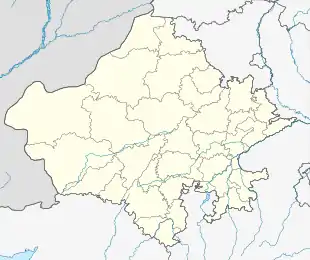Kumbhalgarh Wildlife Sanctuary
Kumbhalgarh Wildlife Sanctuary is located in the Rajsamand District of Rajasthan State in western India.[3] It surrounds the Kumbhalgarh fortress and covers an area of 610.528 km2 (236 sq mi).[2] The sanctuary extends across the Aravalli Range, covering parts of Rajsamand, Udaipur, and Pali districts, ranging from 500 to 1,300 metres (1,600 to 4,300 ft) in elevation. It is part of the Khathiar-Gir dry deciduous forests ecoregion.[4]
| Kumbhalgarh Wildlife Sanctuary | |
|---|---|
 Map of Rajasthan | |
| Location | Rajsamand District, Rajasthan, India |
| Nearest city | Udaipur |
| Coordinates | 24°33′54″N 73°54′22″E[1] |
| Area | 610.528 km2 (235.726 sq mi)[2] |
| Established | 1971 |

Geography
It takes name after the impressive historic fort of Kumbhalgarh. The wildlife sanctuary consists of a 224.890 km2 (87 sq mi) core area and a 385.638 km2 (149 sq mi) buffer area.[2] It covers four hill and mountain ranges of the Aravalli: Kumbhalgarh range; Sadri range; Desuri range and the Bokhada range.[2] Twenty-two villages are located inside the sanctuary.[2] The soils are generally thin, mostly of sandy loam. The base rocks are mainly metamorphic, from the Archean.[2][5] The topography of the sanctuary can be divided into hills, piedmont and plain. The areas of plain have mostly been co-opted for crops.[2]
Kumbhalgarh's natural environment attracts tourists,[6] and is accessible from Udaipur and Nathdwara which are 100 km and 51km respectively from the sanctuary. Foot tracking and horse safari organised by local tour operators are available.[6] A typical safari route enters the sanctuary from the Kumbhalgarh Fort and cuts across the sanctuary to Ghanerao, and then follows an old abandoned road.[7]
Fauna
The sanctuary is home to a variety of wildlife,[3] some of which are endangered species.[6] The wildlife includes the Indian wolf, Indian leopard, sloth bear, striped hyena, Golden jackal, jungle cat, sambhar, nilgai, chausingha (the four horned antelope), chinkara and Indian hare. The leopard is the apex predator in the sanctuary.[2] The birds at Kumbhalgarh includes the normally shy and untrusting grey junglefowl.[8] Peacocks and doves can be sighted feeding on grains scattered by the jungle guards. Birds like the red spurfowl, parakeet, golden oriole, grey pigeon, bulbul, dove and white breasted kingfisher can also be seen near the water holes.
Asiatic Lion Reintroduction Project
Kumbalgarh Sanctuary was one of the places that were considered for the reintroduction of the Asiatic lion.[9] With the recent Supreme Court of India judgment favoring the relocation of lions over that of cheetahs in India, a proposal was made to the Government of Rajasthan, by wildlife conservationist Raza H. Tehsin in April 2009.[10]
See also
References
- "Kumbhalgarh Sanctuary". World Database on Protected Areas. United Nations Environment World Conservation Monitoring Centre. 2014–2018.
- Bohra, Padma (2013). "Kumbhalgarh Wildlife Sanctuary: An Overview". Faunal Exploration of Kumbhalgarh Wildlife Sanctuary Rajasthan. Conservation Area Series, 47. Kolkata: Zoological Survey of India. pp. 1–5. ISBN 978-81-8171-350-6.
- Negi, S. S. (2002). Handbook of National Parks, Wildlife Sanctuaries and Biosphere Reserves in India (Third ed.). Indus Publishing. p. 151. ISBN 978-81-7387-128-3.
- "Khathiar-Gir dry deciduous forests". Terrestrial Ecoregions. World Wildlife Fund. Retrieved 29 January 2017.
- Hatui, Kalyanbrata (2016). "Meso- and micro-scopic structures and Metamorphism from South Delhi Fold Belt, Rajasthan, India: An analysis". Seminar Abstract Volume: Developments in Geosciences in the Past Decade - Emerging Trends for the Future & Impact on Society & Annual General Meeting of the Geological Society of India, 2016. Department of Geology & Geophysics, Indian Institute of Technology Kharagpur. pp. 227–229.
- "Kumbhalgarh Wildlife Sanctuary". Outlook Traveller. Archived from the original on 14 July 2018.
- "Kumbhalgarh Wildlife Sanctuary". Udaipur Tourist Guide. Tourist Places. Archived from the original on 14 July 2018.
- "Grey Junglefowl Gallus sonneratii". Handbook of the Birds of the World. Archived from the original on 14 July 2018.
- Ashraf, N.V.K.; Chellam, Ravi; Sharma, D.; Molur, Sanjay; Walker, Sally, eds. (May 1995). "Asiatic Lion Report" (PDF). Population & Habitat Viability Assessment P.H.V.A. and Global Animal Survival Plan Workshops (18–21 October 1993, Baroda, India). Zoo Outreach Organisation / CBSG, India. Retrieved 25 April 2013.
- "Courting the king". Deccan Herald. 7 August 2012. Retrieved 8 October 2012.